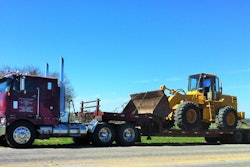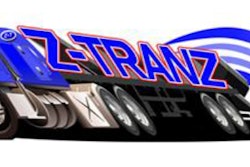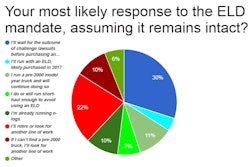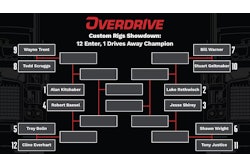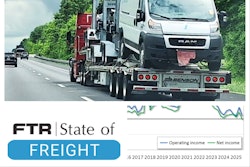The question in the title of this post is one I’ve heard from readers who currently run under lease to a small carrier ever since the mandate final rule for drivers keeping hours of service records of duty status was published last month. Among Overdrive readers, there are many such situated operators. In polling you can access via this link, 34 percent of the magazine’s audience reported running 1999 model year or older equipment. 8 in every 10 pieces of such equipment on the road today, as we’ve shown, is run under the authority of carriers with fewer than 10 trucks.
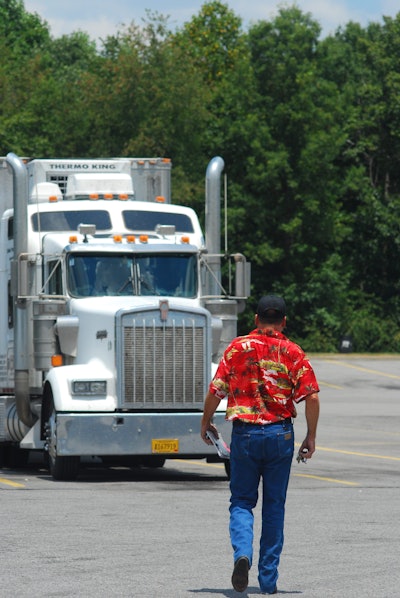 Independent Howard Salmon and his 1999 Kenworth. Hear more from Salmon relative to ELDs at this linked report from the day the mandate was announced.
Independent Howard Salmon and his 1999 Kenworth. Hear more from Salmon relative to ELDs at this linked report from the day the mandate was announced.Whether a carrier will require e-log use of their leased owner-operators with pre-2000 model year equipment, ultimately, depends on the carrier — and could be a good deal more or less likely depending on the carrier’s size, according to today’s bit of an answer to the question in the form of results from a new survey conducted by Overdrive sister fleet publication CCJ.
Those smaller carriers, as might have been expected, are much less likely to require leased owner-operators of pre-2000 equipment to run with an ELD.
How much less likely? Though most such carriers don’t typically lease owner-operators, according to CCJ‘s survey, here’s the distribution of responses for those who do:
Fleets of fewer than 10 trucks: What will be your ELD policy for owner-operators of pre-2000 equipment?
Larger fleets’ ELD policies relative to such owner-operators:
If you’re leased with a 1999 truck, what have you heard from your fleet?

Similar disparities in future plans were seen in response to a question relative to what fleets would do with pre-2000 trucks running the current AOBRD versions of electronic logs today. Very few — 18 percent — of larger carriers noted they’d avoid installation of ELDs on those trucks, and none said they’d take them off of pre-2000 trucks already equipped for e-logs. Among fleets with fewer than 10 trucks, however, 48 percent would avoid installation, and 3 percent would remove e-logs from currently outfitted trucks.
ELD mandate benefits: Rates and pay?
Eventually, contends reader Gary Carlisle, whose directive to regulators to “fix the 14-hour rule” ran as a letter/op-ed in recent months, the mandate for e-logs “may benefit drivers in some ways, but the immediate effect will limit what a driver or owner-operator can do and will therefore limit the potential of his pay.”
Carlisle wrote in responding to our ongoing poll on the long-term future of driver pay models and rates with thoughts that reflect what some commentators on the industry over the years have hoped would be a “silver lining” of sorts to mandated ELDs — a rise in rates and, ultimately, driver pay and owner-operator income. Carlisle just doesn’t see it, particularly not in the short term. Here’s his note today:
Many big-time thinkers that never owned a truck nor were responsible for operations, loading, and delivering freight fail to realize that electronic surveillance will physically limit what drivers do with their time, which is mostly dictated by the loads they load, haul and unload. It will also force the driver to make a decision anytime he feels fatigued within his [14-hour regulated maximum duty day]. Keep in mind that if you limit what a driver can do, the carriers will limit what his pay should be. If you think they all will put them on salary, think about what reason businesses put people on salary. Business will always be a situation where you can afford to pay expenses to render a certain amount of income margin to allow you to remain in business. Freight rates don’t go up just because someone in a magazine or someone from the media says they will. Freight rates go up when freight doesn’t move and get delivered within a required time frame. And then only if that condition is massive failure to pick up and deliver. Therefore, the boon to freight will be delayed and a number of carriers will have to go broke to really get things changed. Then, it will only last until the numbers get back up there and new carriers start slicing the pie again.
E-logs, Carlisle says, will be a “detriment to drivers and owner-operators in the first year or two. Wages will be cut to reflect what you can get delivered. Only after some time, when the dust settles, will wages increase — and then, sparingly.”
Reflecting a rather common view, Carlisle too believes the safety effect will by and large “be negative,” despite the annual $572 million value FMCSA put on the mandate’s expected beneficial effect in crash reductions and lives saved.
As Carlisle speculates, “Best guess is that for every life you feel is saved by the ELD, two more will be taken due to the influx of new green drivers forced into the industry and the increased pressure caused by the electronic surveillance that may limit responsible drivers’ choice of rest in place of the forced window of opportunity to work.”
Which, of course, brings us back to the 14-hour rule. Your thoughts?




